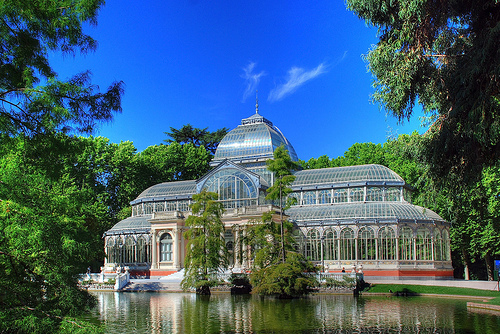

Crystal Palace was built in 1887 in the middle of nature reserve of Parque del Buen Retiro along with an artificial pond that was dug in front of it. Crystal Palace is a glass and iron structure that was designed to exhibit a collection of flowers brought from the Philippines. It was designed by architect Ricardo Velazquez Bosco a three story building with a stone facade decorated with white columns, glass walls and a transparent roof. The structure of the Crystal Palace is fairly light and mobile. It was designed so it could be erected from several pieces and than quickly taken down or even moved to a different location if it was necessary. Nevertheless the building was preserved on its original location. Today Crystal Palace doesn't have any plants, instead it is designed for various art exhibits.
Crystal Palace was built by Ricardo Velázquez
Bosco , and his construction project was inspired by the Crystal
Palace , built in London in 1851 by Joseph Paxton . In London the
Crystal Palace had been erected in Hyde Park in the context of the
Exhibition of Industrial Works, and in Spain the Crystal Palace for
the Exhibition of the Philippine Islands was erected.
Its structure is made of metal, and is completely covered by glass
plates, hence its name. The ceramic decoration used in small friezes
and auctions is the work of Daniel Zuloaga ; of her they emphasize
the figures of grutescos with heads of ducks. 1 The great impression
that the palace must have caused is reflected in this description,
which appeared in El Globo , in 1887.
Interior, where they also show a series of works of modern art.
Crystal Palace as a cathedral of glass, of classic proportions, on a
hill of grass. Its walls aare immense and transparent stained glass
supported by ionic columns of iron, arranged in three naves on a
trefoil shape and crowned by an immense dome , whose height reaches
22.60 meters, covering a great pylon destined to the aquatic plants.
Around, and in the lateral ships, of 14.61 of elevation, they have
to shelter the flexible grasses and high palms characteristic of the
tropical flora of the Philippines. Its majestic front, of classic
taste and Greek style, falls on a terrace surrounded by elegant
baluster, and looks at the lake, which extends at its feet like a
mirror where you have to look at the slender trunks, the green
fronds and the painted corollas that await the Palace.
At its feet there is an artificial lake (there is a staircase that
is submerged inside it), where you can find several examples of
cypress swamps ( Taxodium distichum ), whose main characteristic is
that part of its trunk and its roots are under water. The building
is surrounded by horse chestnuts .
On May 10, 1936, the Palacio de Cristal del Retiro was the stage on
which Manuel Azaña was elected as president of the Republic . The
Cortes had remained small to host the mixed assembly of deputies and
delegates and the Palacio de Cristal was elected for the vote and
took office. Azana only candidate, was elected by 754 votes to 874.
2
In 1975 an integral reparation was carried out that returned to the
Palace the original aspect. Currently, it is co-managed by several
entities ( Madrid City Council , Reina Sofía Museum ...) and
exhibitions of contemporary art are held inside.
In 1992 in the District of Arganzuela of Madrid was inaugurated
another Crystal Palace.